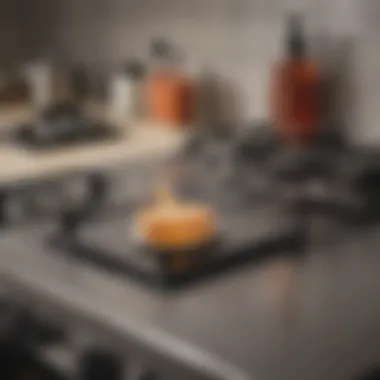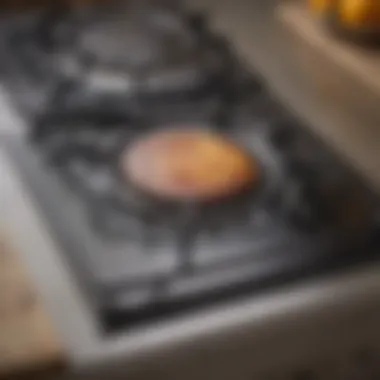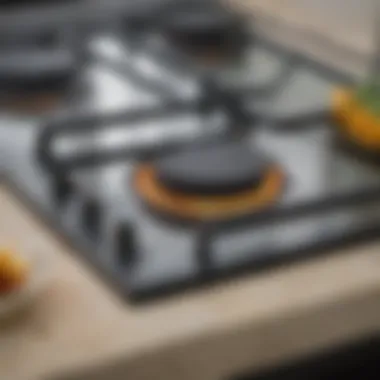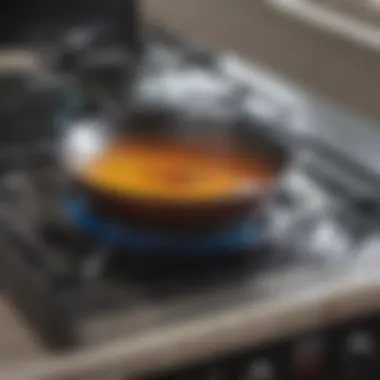A Complete Guide to Cleaning Your Glass Top Stove


Intro
Cleaning a glass top stove is an essential task for maintaining its appearance and functionality. With proper care and attention, your stove can remain a sleek focal point in your kitchen. However, many home cooks face challenges when it comes to keeping their glass top stoves spotless. This guide aims to clarify techniques, suitable products, and maintenance tips to ensure your stove stays in optimal condition. Understanding these aspects can not only enhance the aesthetics of your kitchen but also prolong the lifespan of your appliance.
Many factors contribute to the need for careful stove cleaning. Frequent cooking can lead to grease build-up, stubborn food residues, and minor scratches. Conventional cleaning methods may not always be suitable for glass tops, leading to potential damage. Therefore, this article delves into effective approaches, addressing various types of stains and spills you might encounter in daily use. Additionally, we will discuss preventative measures to keep your stove looking like new.
Each section of this guide seeks to empower readers with knowledge, ensuring that maintaining a glass top stove is not just simple but satisfying. Cleaning does not merely involve removing stains but also understanding what products are effective and safe for glass surfaces. Through strategic cleaning practices and consistent maintenance, you can achieve results that reflect care and responsibility in your kitchen's upkeep.
Prologue to Glass Top Stoves
Glass top stoves have becom a popular choice in modern kitchens due to their sleek appearance and practical functionality. This introduction serves to highlight the importance of understanding these appliances, particularly in relation to their cleaning and maintenance.
Understanding Glass Top Stove Construction
Glass top stoves are typically made of a smooth ceramic or glass surface, which is designed to provide even heat distribution. Beneath this surface, electric heating elements or induction coils heat up to cook your food. The design allows for a seamless look, making it aesthetically pleasing and easy to integrate into various kitchen styles. However, this construction also means that specific care is required to preserve the surface's integrity and performance. Knowledge of how a glass top stove works can help in selecting proper cleaning methods and products that will not damage the surface.
Benefits of Glass Top Stoves
Glass top stoves offer several benefits that cater to a variety of cooking needs:
- Easy Cleanup: The smooth surface allows for quick wiping without the hassles of traditional burners.
- Modern Look: The sleek design enhances the overall kitchen aesthetic, making it look contemporary.
- Heat Distribution: Even heating ensures that food is cooked thoroughly and reduces hot spots.
- Safety Features: Many models come with safety locks and indicators that show when the surface is hot.
Overall, these benefits make glass top stoves a convenient and efficient choice for cooking enthusiasts.
The Importance of Regular Cleaning
Maintaining a clean glass top stove is not just about aesthetics. Regular cleaning plays a vital role in ensuring the appliance operates efficiently and remains in good condition. Over time, residue from cooking can accumulate, leading to potential issues such as stubborn stains and reduced functionality.
Preventing Stains and Scratches
One of the primary reasons to commit to regular cleaning is to prevent stains and scratches from forming on the surface. These stains can arise from various sources, such as food spills, oil splatters, and burnt-on residues. Not addressing these spills promptly can make them difficult to remove over time, compromising the stove's appearance and potentially leading to permanent marks.
To minimize the risk of stains, it is important to clean the stove as soon as it cools down and after each cooking session. A soft cloth or sponge, paired with suitable cleaning solutions specifically made for glass tops, can effectively lift away these residues. Using abrasive materials like steel wool or coarse sponges, however, should be avoided as they can cause scratches that mar the glass surface permanently.
Enhancing Longevity of Your Stove
Regular maintenance not only prevents stains but significantly enhances the longevity of your stove. When dirt and residue are allowed to accumulate, they can lead to operational problems that might necessitate costly repairs or even premature replacement of the appliance. By engaging in routine cleaning practices, you help ensure that the heating elements operate efficiently, and the glass surface maintains its integrity.
A clean stove is less likely to overheat because it can conduct heat more efficiently. This efficiency can lead to a lower energy bill over time. Additionally, consistent care can help identify small issues before they escalate into serious problems. This can ultimately save both time and money for the homeowner.
"A clean glass top stove means a safer and more efficient cooking environment."
Overall, the importance of regular cleaning cannot be understated. It is a small investment of time that yields significant benefits in protecting your appliance and optimizing cooking results.
Essential Cleaning Products
In maintaining a glass top stove, the choice of cleaning products is crucial. Using the right cleaners not only aids in achieving a spotless surface but also preserves the integrity of the glass finish. Some products may contain harsh chemicals that can damage the glass or leave residues that are not easy to remove. Therefore, it is imperative to select cleaning solutions that are specifically formulated for glass top stoves.
Using appropriate cleaning products may prevent scratches and wear over time. Many cleaners are designed with a fine balance of effectiveness and safety, ensuring they can tackle tough stains without harming the stove surface. Additionally, these products often enhance the shine of the glass, contributing to an overall cleaner kitchen appearance.
Recommended Cleaners for Glass Stoves


When choosing a cleaner for your glass top stove, look for products labeled specifically for glass. Popular options include brands like Cerama Bryte and Bar Keepers Friend. These cleaners effectively remove food residues and stains while fostering shine.
- Cerama Bryte Cleaner: This is a widely endorsed product among home cooks. Its gentle formula is tough on grime but safe on the surface. It provides clear instructions on use, which contributes to ease of cleaning.
- Bar Keepers Friend Cookware Cleaner: Known for its versatility, this cleaner is effective not just on glass top stoves but also on stainless steel and ceramic pots. It contains no harsh abrasives, making it safe for regular use.
- Weiman Glass Cook Top Cleaner: This cleaner comes in a convenient wipe format for easy application. It is effective in combating burnt-on food and grease, making it ideal after heavy cooking sessions.
Make sure to follow the instructions on the cleaner's packaging. This ensures maximum effectiveness and safety.
Homemade Cleaning Solutions
For those who prefer to use natural solutions, making your own cleaning mixture can be both cost-effective and eco-friendly. Homemade cleaners often consist of common household ingredients that are effective at breaking down grease and removing stains.
- Vinegar and Water: A simple but effective combination. Mix equal parts of white vinegar and water in a spray bottle. This solution can help dissolve greasy residues and set-in stains.
- Baking Soda Paste: Combining baking soda with a little water forms a gentle abrasive paste. Apply this paste to stubborn areas and let sit for a few minutes before scrubbing gently with a soft cloth.
- Lemon Juice and Baking Soda: Lemon juice works as a natural degreaser due to its acidity. Mixing it with baking soda forms a bubbling reaction, which helps lift stains when applied to the affected areas.
Using these homemade solutions is straightforward. Spray or apply, let it sit, and wipe clean. Just ensure that any abrasive components are used sparingly to avoid damaging the stove's surface.
Tip: Always test homemade solutions on a small, inconspicuous area before applying them freely to ensure they will not cause damage.
Step-by-Step Cleaning Process
Cleaning your glass top stove is not simply about removing visible stains; it is a procedural endeavor that enhances its appearance and functionality. This section focuses on the systematic approach to cleaning, which is essential for maintaining the integrity and aesthetic of the stove. A step-by-step cleaning process allows for thoroughness, ensuring that every aspect is addressed. By following a structured method, one can effectively minimize the risk of damage while maximizing cleanliness and hygiene.
Initial Assessment of Stove Condition
Before engaging in the actual cleaning process, it is crucial to assess the condition of your stove. Look for any visible stains, scratches, or residue that may have accumulated. Understanding the current state of the stove will guide your cleaning strategy. For instance, if the glass surface exhibits tough stains or minor scratches, specific techniques may be required to prevent further damage. A careful assessment helps in selecting the appropriate tools and cleaning products, ensuring a tailored approach to your cleaning endeavors.
Gathering Necessary Tools
Having the right tools is vital for an effective cleaning process. A checklist can help streamline this part:
- Soft cloths: Microfiber cloths are preferable, as they minimize scratching.
- Sponge: A non-abrasive sponge for scrubbing.
- Glass cleaner: Specifically designed for glass top stoves.
- Baking soda: A natural cleaning alternative that works well with tough stains.
- Vinegar solution: Useful for disinfecting and removing greasy residue.
Assembling these tools in advance reduces interruptions during the cleaning process. Each tool plays a role in facilitating a thorough clean, ensuring no element of dirt is left unaddressed.
Cleaning Procedure
Preheating the Stove
Preheating the stove can be a beneficial step, particularly for loosening baked-on food residues. When you turn on the stove at a low heat setting, the heat helps lift stubborn particles, making them easier to clean. Warming the surface promotes the efficiency of the cleaning agents used later. However, it is important to ensure that the stove is not too hot when applying cleaners, as this could lead to damaging the surface. This balance makes preheating a utilitarian approach in the cleaning routine.
Applying Cleaner
Once the stove is preheated and cooled down slightly, apply a compatible cleaner. Choose a glass top stove cleaner that is safe for use or a homemade solution utilizing vinegar or baking soda. Spraying a generous amount allows the product to penetrate dirt and grime effectively. This process softens difficult stains, enabling a more effortless scrubbing later. Avoid harsh chemicals that can degrade the surface or alter its shine. A suitable cleaner optimizes the cleaning experience, yielding results without adverse consequences.
Scrubbing Techniques
After the cleaner has settled, it’s time to scrub. Use a non-abrasive sponge or cloth to gently scrub the surface. Focus on stained areas, applying light pressure to avoid scratching the surface. Using circular motions is effective for lifting stubborn stains without embedding dirt particles further into the surface. Understanding the appropriate pressure to apply is key: too much force can damage the glass, while too little may be ineffective. The right scrubbing techniques ensure a gentle yet thorough cleaning process.
Rinsing and Wiping Down
The final step in the cleaning procedure involves rinsing and wiping down the surface. Use a damp cloth to remove any residue from the cleaner. It is essential to ensure that no cleaner remains on the surface, as this can lead to streaking or further residue buildup. Finish with a dry microfiber cloth to prevent any water spots and enhance shine. Rinsing and wiping are integral parts of the cleaning journey, contributing to the overall visual appeal of the stove.
Final Touches for a Sparkling Finish
Once the stove has been cleaned, some final touches can elevate its appearance. Inspect for any remaining spots and address them as necessary. A final buff with a dry cloth can make the stove shine even brighter. Being meticulous about these finishing touches reflects the level of care put into the cleaning process. Not just aesthetics, but these practices extend the life of the glass top stove, making this step critical to any cleaning regimen.


Dealing with Stubborn Stains
Stubborn stains on glass top stoves can be a significant inconvenience for many users. These stains can frustrate cooks who rely on a clean cooking surface for meal preparation. Understanding how to identify and remove these tough stains is an essential part of maintaining your stove's appearance and functionality. Successful removal not only improves the look of the stove but also ensures safe cooking practices. Regular attention to these stains can prevent them from becoming more embedded, making future cleaning efforts easier.
Identifying Types of Stains
The first step in addressing stubborn stains is being able to identify them accurately. There are different types of stains that can occur on glass top stoves, each with distinct characteristics. Common types include:
- Burnt Food Residue: This type often appears as darkened spots or marks, typically resulting from spills that did not get cleaned promptly.
- Oil and Grease Marks: These stains usually leave a shiny film and can make the surface appear dull over time if not addressed.
- Water Spots: These are light stains, often caused by hard water, which can leave mineral deposits on the surface.
- Cookware Scratches: While not a stain per se, scratches from abrasive cookware can mar the surface and make it appear stained.
Recognizing these various stains will help tailor your cleaning approach effectively. It is important to know that each type may require different techniques for optimal removal.
Techniques for Removing Tough Stains
Once you have identified the type of stain you are dealing with, you can employ specific techniques to achieve the best results.
- For Burnt Food Residue:
- For Oil and Grease Marks:
- For Water Spots:
- For Scratches:
- Allow the stove to cool completely.
- Gently scrape the residue using a plastic scraper, taking care not to scratch the surface.
- Apply a suitable glass stove cleaner and leave it for several minutes before wiping away with a soft cloth.
- Use a combination of baking soda and water to create a paste.
- Spread this paste over the stained area and let it sit for about 15 minutes.
- Scrub gently with a non-abrasive sponge and rinse with warm water to remove residue.
- Mix equal parts of vinegar and water in a spray bottle.
- Spray the solution on the affected area and let it sit for several minutes before wiping clean with a microfiber cloth.
- While scratches can be tricky, you can try using a specialized scratch repair product designed for glass stoves.
- Follow the manufacturer's instructions carefully to avoid further damaging the surface.
Regular assessment and timely cleaning of stains will prolong the life of your glass top stove.
By utilizing these identifying techniques and applicable methods for tough stains, one can maintain a beautiful cooking surface and prevent future problems.
Preventative Maintenance Tips
Maintaining your glass top stove is crucial to ensuring its longevity and functionality. Preventative maintenance tips are key in preserving the surface and enhancing its performance over time. Utilizing these strategies can significantly minimize the likelihood of stains, scratches, and other damage, allowing your stove to remain in pristine condition for years.
Daily Care Practices
Engaging in daily care practices is vital for maintaining the appearance and performance of your glass top stove. Here are several practices to consider:
- Wipe Down After Use: After each cooking session, take a moment to wipe down the stove with a damp cloth. This removes food particles and liquids that could potentially lead to stains if left unattended.
- Use Soft Cloths: Choose soft, non-abrasive cloths for cleaning. Materials such as microfiber are gentle on the surface and effective at picking up residues without scratching.
- Spot Clean Spills Promptly: Address any spills immediately. Use a paper towel or cloth to blot the area rather than rubbing it, which could spread the mess and cause further issues.
- Avoid Harsh Chemicals: Refrain from using abrasive cleaners or pads that might scratch the glass. Stick with products designed specifically for glass features to protect your stove’s finish.
Best Practices Following Cooking
Following cooking, there are certain best practices to adopt that can enhance the maintenance of your glass top stove:
- Let the Stove Cool: Allow the stove to cool down before cleaning. This prevents burns and ensures that any residual heat won't react negatively with cleaning products.
- Use Appropriate Cleaners: Select cleaners that are safe for glass top stoves. Brands like Cerama Bryte or Weiman offer solutions specifically formulatd for this purpose. Follow the instructions carefully to avoid damaging the surface.
- Use a Scraper for Residues: For hardened residues, it may be necessary to gently scrape them away using a plastic scraper. This minimizes the risk of scratches while effectively removing stuck-on food.
- Regular Deep Clean: Schedule a regular deep cleaning every few weeks. This can include thorough scrubbing and the use of a glass stove cleaner to maintain clarity and shine.
"Regular maintenance is as important as cleaning. These small daily practices save time and effort in the long run."
By incorporating these preventative maintenance tips, you can greatly enhance the durability and appearance of your glass top stove. It’s always wiser to take proactive measures than to react to problems that arise after neglect.
Addressing Common Issues


Cleaning glass top stoves is not solely about maintaining visual appeal but also about ensuring functionality and prolonging the life of your appliance. Common issues arise during use that may include scratches, damage, and residue. This section focuses on how to tackle these problems effectively. Understanding these challenges prepares you to maintain your stove in optimal condition.
Scratches and Damage Recovery
Scratches on glass top stoves can be disheartening. They often result from the use of rough cookware or improper cleaning tools. Identifying the level of scratching is crucial in addressing them.
For minor scratches, there are commercial products available that can help reduce their visibility.
- Ceramic Cooktop Cleaner: This product restores shine and minimizes the appearance of scratches.
- Baking Soda Paste: Mixing baking soda with water can create a gentle abrasive that helps to polish the surface. Apply the paste, let it sit briefly, then gently scrub with a soft cloth.
For deeper scratches, while they may be more challenging to deal with, they often remain a cosmetic concern. Applying a heat-resistant epoxy can fill in some scratches. However, if a fracture is significant, it’s advisable to consult a technician for possible replacement or repair.
Resolving Residue Build-Up
Residue build-up is a common issue that can occur on glass top stoves due to spills or cooking splatters. Addressing this problem promptly is important to prevent stubborn stains and ensure the cooking surface remains clean.
First, assess the type of residue. Greasy stains often require different treatments compared to burnt-on food. Here are steps for effective residue removal:
- Immediate Action: Wipe up spills as soon as possible to prevent them from hardening.
- Use of Recommended Cleaners: Apply a glass stove cleaner that is specifically designed for tough residues. Follow instructions closely.
- Manual Scrubbing: Use a non-abrasive sponge to scrub the affected area gently, ensuring not to damage the glass.
- Rinsing: Make sure to rinse the area thoroughly with a clean cloth and warm water to remove any residue from the cleaner.
- Drying: Finally, dry the surface to prevent water spots, using a microfiber cloth.
Regular maintenance can help prevent residue build-up and keep your glass top stove looking new.
Resources for Further Information
Acquiring the correct knowledge for maintaining a glass top stove is crucial. The right resources can help both novice and experienced cooks keep their stoves looking pristine and functioning effectively. This section explores two main resources: manufacturer guidelines and community forums. Both resources provide valuable insights that can greatly assist in achieving optimal cleaning results.
Manufacturer Guidelines
Manufacturer guidelines serve as a primary resource when it comes to maintaining a glass top stove. They contain specific instructions aimed at ensuring the functionality and longevity of your appliance. Each brand may have its unique recommendations regarding cleaning products and methods.
- Cleaning Products: Many manufacturers recommend particular cleaners that are safe and effective for their glass top surfaces. Using these advised products can prevent damage that generic cleaners might cause.
- Cleaning Frequency: Guidelines also often stipulate how frequently one should clean the stove. Regular cleaning can enhance performance and appearance.
- Warranty Information: Following the manufacturer’s instructions can also prevent any warranty issues that may arise from improper maintenance.
Real-world guidance directly from manufacturers can provide the best practices tailored to your appliance. For further information, always check resources like Wikipedia or Britannica for detailed articles on appliance maintenance and care.
Community Forums and Support
Community forums offer a platform for users to share personal experiences and tips about cleaning glass top stoves. These platforms, such as those found on Reddit or Facebook, can be exceptionally insightful.
- Personal Tips: Users share successful techniques that are often not found in official guidelines. This includes personal recommendations for homemade cleaners and tricks seen in practice.
- Problem Solving: If you encounter specific issues, forums can provide real-time support. Other home cooks often contribute solutions that may work better than conventional methods.
- Unique Experiences: Different cleaning challenges arise based on stove use, and community members often relay solutions tailored to specific problems, including stubborn stains.
Community forums create a collaborative atmosphere for problem-solving and sharing best practices which can elevate the cleaning process from routine maintenance to a more informed and engaging experience. Thus, both manufacturer guidelines and community resources are essential elements for comprehensive knowledge in maintaining your glass top stove.
End
Cleaning and maintaining a glass top stove is not merely a chore but an essential practice to ensure its longevity and efficiency. In this article, we have explored various aspects of stove care that facilitate both optimal performance and aesthetic appeal. A clean glass top stove not only enhances the overall kitchen experience but also contributes significantly to safety and hygiene.
Summarizing Key Points
To reiterate, several key points stand out from the discussion:
- Regular Cleaning: Engaging in frequent cleaning prevents the buildup of grime and reduces the risk of scratches, thereby maintaining the glass surface.
- Effective Employing Cleaning Products: Choosing the right cleaners, whether commercially available or homemade, can determine the ease of cleaning and the quality of the results.
- Techniques for Tough Stains: Understanding different types of stains and the appropriate removal techniques can help in addressing stubborn blemishes efficiently.
- Maintenance Tips: Daily practices and proper post-cooking care significantly protect the stove from wear and tear.
These elements come together to emphasize that a well-maintained glass top stove not only functions better but also adds value to your kitchen space.
Encouraging Regular Maintenance
Regular maintenance should be viewed as an investment in the appliance's durability and your cooking experience. By incorporating simple practices into your daily routine, you can ensure that your glass top stove remains in top condition:
- Wipe the surface daily: A quick wipe with a soft cloth after cooking can prevent spills from setting in.
- Avoid abrasive materials: Using non-abrasive cleaning tools will help prevent scratches and damage.
- Use a protective cover: When not in use, a stove cover can help shield the glass from dust and potential stains.







